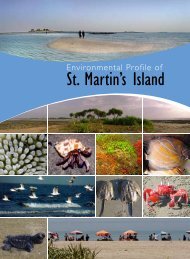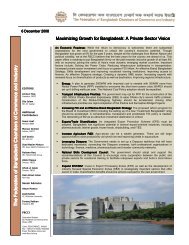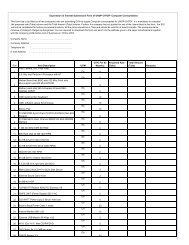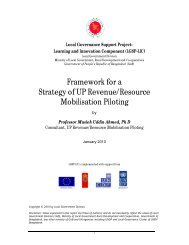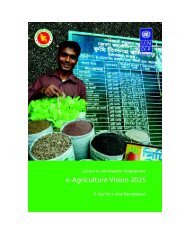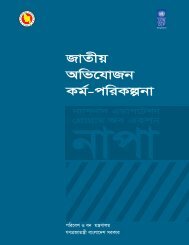The probable impacts of climate change on poverty - UNDP
The probable impacts of climate change on poverty - UNDP
The probable impacts of climate change on poverty - UNDP
You also want an ePaper? Increase the reach of your titles
YUMPU automatically turns print PDFs into web optimized ePapers that Google loves.
extreme. Key difference will be frequency, intensity and scale <str<strong>on</strong>g>of</str<strong>on</strong>g> the problem. Similar to the present situati<strong>on</strong>, flood<br />
will have both positive and negative <str<strong>on</strong>g>impacts</str<strong>on</strong>g> in future. Flood will affect aquaculture infrastructure, p<strong>on</strong>d siltati<strong>on</strong>,<br />
habitat <str<strong>on</strong>g>of</str<strong>on</strong>g> fish breeding at larger scale while increased area under inundati<strong>on</strong> and l<strong>on</strong>g durati<strong>on</strong> is likely to increase<br />
open water fisheries. Drought will affect fish growth, breeding & producti<strong>on</strong>, increase disease vulnerability, reduce<br />
fishing seas<strong>on</strong> and reduce broods <str<strong>on</strong>g>of</str<strong>on</strong>g> natural SIS. Probable <str<strong>on</strong>g>impacts</str<strong>on</strong>g> <str<strong>on</strong>g>of</str<strong>on</strong>g> cycl<strong>on</strong>e are almost similar to existing <str<strong>on</strong>g>impacts</str<strong>on</strong>g><br />
but severity will be increased which will affect <strong>poverty</strong> at wider scale. Salinity intrusi<strong>on</strong> and erratic rainfall will also<br />
affect fish producti<strong>on</strong>.<br />
6.4 Livestock<br />
Assessment <str<strong>on</strong>g>of</str<strong>on</strong>g> <str<strong>on</strong>g>impacts</str<strong>on</strong>g> <str<strong>on</strong>g>of</str<strong>on</strong>g> <str<strong>on</strong>g>climate</str<strong>on</strong>g> <str<strong>on</strong>g>change</str<strong>on</strong>g> <strong>on</strong> livestock is also limited. However, it is suggested that extreme<br />
temperature and <str<strong>on</strong>g>climate</str<strong>on</strong>g> <str<strong>on</strong>g>change</str<strong>on</strong>g> related natural disasters would affect livestock significantly. High temperature<br />
would affect livestock in a number <str<strong>on</strong>g>of</str<strong>on</strong>g> ways: causes great discomfort as in the case <str<strong>on</strong>g>of</str<strong>on</strong>g> human, decreases feed intake<br />
and alters nutrient metabolism leading to high loss <str<strong>on</strong>g>of</str<strong>on</strong>g> energy and the combined effects <str<strong>on</strong>g>of</str<strong>on</strong>g> discomfort and nutrient<br />
metabolism reduces their productivity, resulting in financial loss for the farmers. Apart from extreme temperature,<br />
natural disasters such as cycl<strong>on</strong>e and tidal surge as menti<strong>on</strong>ed above, also cause immense loss and sufferings to<br />
livestock through destructi<strong>on</strong> <str<strong>on</strong>g>of</str<strong>on</strong>g> forage crops as well as housing. Deaths <str<strong>on</strong>g>of</str<strong>on</strong>g> livestock due to cycl<strong>on</strong>e and storm<br />
surge are huge in the coastal area.<br />
<str<strong>on</strong>g>The</str<strong>on</strong>g> c<strong>on</strong>sultati<strong>on</strong> workshops and key experts’ interviews state that livestock sector is badly affected by <str<strong>on</strong>g>climate</str<strong>on</strong>g><br />
variability and shocks. Flood, cycl<strong>on</strong>e and sea level rise have major <str<strong>on</strong>g>impacts</str<strong>on</strong>g> <strong>on</strong> livestock. Flood causes loss <str<strong>on</strong>g>of</str<strong>on</strong>g><br />
livestock, damage pasturelands which increase fodder scarcity and diseases <str<strong>on</strong>g>of</str<strong>on</strong>g> livestock. Cycl<strong>on</strong>e and storm surge<br />
causes huge loss <str<strong>on</strong>g>of</str<strong>on</strong>g> animal lives and shelters, damage <str<strong>on</strong>g>of</str<strong>on</strong>g> fodder, poor health and disease outbreak. Ultimately it<br />
results reducti<strong>on</strong> <str<strong>on</strong>g>of</str<strong>on</strong>g> livestock populati<strong>on</strong>. Sea level rise and associated coastal inundati<strong>on</strong> leads to inundati<strong>on</strong> <str<strong>on</strong>g>of</str<strong>on</strong>g><br />
pastureland and increase animal feed scarcity and increase incidence <str<strong>on</strong>g>of</str<strong>on</strong>g> animal diseases. It also reduces animal<br />
rearing coverage. Drought hampered the producti<strong>on</strong> <str<strong>on</strong>g>of</str<strong>on</strong>g> livestock, increase management cost through incidence <str<strong>on</strong>g>of</str<strong>on</strong>g><br />
diseases and increase food scarcity which results poor health <str<strong>on</strong>g>of</str<strong>on</strong>g> livestock. Besides, salinity intrusi<strong>on</strong>, temperature<br />
variati<strong>on</strong> and heat wave cause harm to livestock affecting fodder land and health <str<strong>on</strong>g>of</str<strong>on</strong>g> poultry and other<br />
domesticated animals.<br />
It is difficult to have percepti<strong>on</strong> <strong>on</strong> the <str<strong>on</strong>g>impacts</str<strong>on</strong>g> <str<strong>on</strong>g>of</str<strong>on</strong>g> <str<strong>on</strong>g>climate</str<strong>on</strong>g> <str<strong>on</strong>g>change</str<strong>on</strong>g>, variability and extremes <strong>on</strong> livestock because<br />
there is no baseline informati<strong>on</strong> <strong>on</strong> these exist. But it is easily perceived that death and producti<strong>on</strong> <str<strong>on</strong>g>of</str<strong>on</strong>g> livestock will<br />
decrease c<strong>on</strong>siderably with increasing intensity and frequency <str<strong>on</strong>g>of</str<strong>on</strong>g> shocks. Producti<strong>on</strong> <str<strong>on</strong>g>of</str<strong>on</strong>g> livelihood will also<br />
hampered due to decrease <str<strong>on</strong>g>of</str<strong>on</strong>g> grazing lands, increase death <str<strong>on</strong>g>of</str<strong>on</strong>g> livestock etc. <str<strong>on</strong>g>The</str<strong>on</strong>g>se will lead to decrease health<br />
status affecting meat and milk producti<strong>on</strong>.<br />
6.5 Forestry<br />
Cycl<strong>on</strong>e and storm surges al<strong>on</strong>g with salinity intrusi<strong>on</strong> are the major shocks for forestry sector, stated by the key<br />
experts. Cycl<strong>on</strong>e damages forest and scale <str<strong>on</strong>g>of</str<strong>on</strong>g> damage depends <strong>on</strong> severity <str<strong>on</strong>g>of</str<strong>on</strong>g> cycl<strong>on</strong>e and storm surges. <str<strong>on</strong>g>The</str<strong>on</strong>g> supper<br />
cycl<strong>on</strong>e Sidr destructed <strong>on</strong>e-quarter <str<strong>on</strong>g>of</str<strong>on</strong>g> the Sundarbans and almost 100% afforested trees al<strong>on</strong>g its path. It has been<br />
observed that all the trees at road sides as well as homesteads <str<strong>on</strong>g>of</str<strong>on</strong>g> about 10 to 15 years old have been destructed by<br />
the Sidr. It means, 10-15 years <str<strong>on</strong>g>of</str<strong>on</strong>g> investments <str<strong>on</strong>g>of</str<strong>on</strong>g> individuals <strong>on</strong> homestead forestry as well as afforestati<strong>on</strong> have<br />
been simply diminished within <strong>on</strong>ly a few hours. Salinity intrusi<strong>on</strong> has also adverse effects <strong>on</strong> freshwater forest<br />
ecosystem. It affects adversely the flora and fauna compositi<strong>on</strong>. Flood and river bank erosi<strong>on</strong> moderately affect<br />
forest and cause loss <str<strong>on</strong>g>of</str<strong>on</strong>g> biodiversity, mortality <str<strong>on</strong>g>of</str<strong>on</strong>g> flood susceptible trees and plants and destroy both aquatic and<br />
terrestrial ecosystems.<br />
In the north-western part <str<strong>on</strong>g>of</str<strong>on</strong>g> the country, drought badly affects trees and plants due to moisture stress <str<strong>on</strong>g>of</str<strong>on</strong>g> the soil.<br />
Branches and leaves <str<strong>on</strong>g>of</str<strong>on</strong>g> trees are dried up due to lack <str<strong>on</strong>g>of</str<strong>on</strong>g> moisture and excessive evapo-transpirati<strong>on</strong>. Besides, erratic<br />
rainfall, heat wave, and temperature variati<strong>on</strong> cause harm to germinati<strong>on</strong> <str<strong>on</strong>g>of</str<strong>on</strong>g> seeds and transfer <str<strong>on</strong>g>of</str<strong>on</strong>g> species from <strong>on</strong>e<br />
place to another. Temperature variati<strong>on</strong> brings <str<strong>on</strong>g>change</str<strong>on</strong>g>s in species <str<strong>on</strong>g>of</str<strong>on</strong>g> natural hill forest.<br />
A large number <str<strong>on</strong>g>of</str<strong>on</strong>g> people depend <strong>on</strong> forest resources particularly <strong>on</strong> the natural forest and forest product. Forestry<br />
sector will be affected by <str<strong>on</strong>g>climate</str<strong>on</strong>g> induced shocks and <str<strong>on</strong>g>change</str<strong>on</strong>g>s at higher scale. Flood will cause loss <str<strong>on</strong>g>of</str<strong>on</strong>g> trees and<br />
<str<strong>on</strong>g>The</str<strong>on</strong>g> Probable Impacts <str<strong>on</strong>g>of</str<strong>on</strong>g> Climate Change <strong>on</strong> Poverty and Ec<strong>on</strong>omic Growth and<br />
the Opti<strong>on</strong>s <str<strong>on</strong>g>of</str<strong>on</strong>g> Coping with adverse Effect <str<strong>on</strong>g>of</str<strong>on</strong>g> Climate Change in Bangladesh<br />
49



